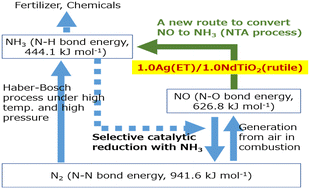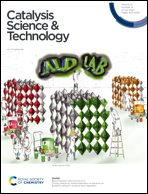Catalysts for selective conversion of nitric oxide to ammonia (NTA) with propene in the presence of a large excess of oxygen and water vapor†
Abstract
Catalysts for the NO to NH3 reaction in the presence of 10% O2 and 10% H2O were investigated on a TiO2(rutile) support. The activity sequence of the various metals supported at 2 wt% was Ag > Ni > Zn > Sn = Bi > In > others (22 elements in total). The Ag/TiO2 catalyst with the highest activity was further investigated to increase and stabilize the activity. The metallic silver particles prepared by ethanol reduction of Ag in solution were supported on TiO2 (ET method). Silver was supported as fine particles, and the activity was significantly improved. However, repeated use of the ET catalysts at 500–300 °C resulted in Ag agglomeration and a significant decrease in activity. In order to prevent activity degradation at high temperatures, the catalyst was used only at temperatures below 400 °C, and stable activity was obtained. The addition of 0.25% C3H6 was found to be sufficient to convert half of 0.1% NO to NH3 on 1.0AgET/TiO2. To stabilize the catalytic activity of AgET/TiO2, Nd was loaded onto the TiO2 support prior to Ag loading (ND method). The loading of 1–5 mol% Nd resulted in the formation of new pores with a diameter of 14 nm. 1.0AgET/1NdTiO2 gave higher ammonia yields than 1.0AgET/5NdTiO2, and was more stable. The dependence on Ag loading (0.7–5.0 wt%) on 1NdTiO2 was measured and it was found that the catalyst loaded with 1.0 wt% Ag gave the highest activity. The activity change in repeated experiments was very small for all the ND-ET catalysts. The NH3 yield reached 88% under the reaction conditions of 0.1% NO, 0.5% C3H6, 10% O2, 10% H2O, balanced N2, and a space velocity of 10 000 h−1. Finally, the activities for the C3H6 and NH3 combustion were measured. NH3 can be produced at the temperature of C3H6 combustion and consumed at the temperature of NH3 combustion. Due to the Ag loading, the temperature for C3H6 combustion became much lower than that for NH3 combustion, indicating that the NH3 formation activity was greatly enhanced by supporting Ag. It was also found that the NH3 combustion activity of AgET/TiO2 became higher on the catalysts used repeatedly, resulting in a narrowing of the ammonia production temperature range. The effect of reducing gas species was also investigated.



 Please wait while we load your content...
Please wait while we load your content...